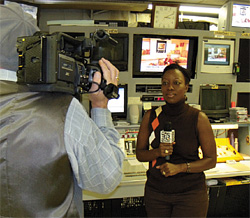Making the HD Leap

(L to R) WLTZ-TV news anchors Jeremy Moss, Nathan O'Leary, Sunya Walls and Evan HutchinsonTORONTO
As the DTV transition moves towards its final deadline—at least final for now—smaller market U.S. TV stations are taking the plunge in HD newscast production and newsgathering. Yet their reasons for doing so vary widely, as do the ways they are reaching this goal, and the schedules they have set themselves for achieving it.
Many smaller market news operations have embraced HDTV simply because they see their audiences doing so.
Such is the case for KCTV/KSMO TV in Kansas City, Mo.
"As viewers began to invest in HD capable displays we felt the need to provide viewers with a good looking product that would take advantage of the technology," said Tom Casey, KCTV/KSMO TV's director of engineering. In addition, there are three competitors in KCTV/KSMO's market doing HD news already, which "helped motivate our move to HD," he says. "As viewers began their search for compelling HD content we did not want be passed by because we weren't HD yet."
WLTZ, the NBC affiliate in Columbus, Ga., has been out of the news business since 1993. After SagamoreHill Broadcasting purchased the station in 2007, "We wanted to get back into the business and wanted to give the viewers something different," said WLTZ GM Drew Rhodes. "We wanted to serve the community better than the other guys. With limited resources for manpower, we figured this was a way we could differentiate ourselves from the competition... the quality of the graphics and the resolution of the video really made the competition take note."
However, WRGB in Schenectady, N.Y. made the move for HD for technical reasons, rather than the desire to attract new eyeballs.
"The motivation to do HD news was to take advantage of new technology," says Fred Lass, WRGB's director of engineering. "If the ratings increased, all the better."
In fact, Lass lists moving to HD news as the fourth most important reason his station made the switch. The first priority was, as he mentioned, "new master control automation," followed by the fact that his master control is running both WRGB and its sister station WCWN, followed by automating the news operation.
THE EQUIPMENT THEY CHOSE

TD Reed Erickson works on pre-production for KOMU 8 News at Six.
One unique example among stations adopting HD news is KOMU, which is owned and operated by the University of Missouri in Columbia-Jefferson City, Mo. Since the University runs a journalism school, KOMU's staff is drawn from this base of students and graduates. "The result is that we have a very young talent pool who adapt easily to new technology and trends, said Stacey Woelfel, KOMU's news director.
It is for this reason that KOMU is shooting HD news on small Sony XDCAM EX camcorders. "We saw it at NAB a few years ago," Woelfel said. "We could tell by its small form factor and prosumer styling that it would be a good fit with our operation, given that we work with students and pros." For the record, KOMU works with Avid NewsCutter and Final Cut Pro HD nonlinear editors, and produces its entire newscast in HD.
In the more traditional newsgathering world, KCTV/KSMO chose a Grass Valley Kayak switcher "as it simply required changing a menu setting that changed the output from SD to HD," said Casey. "Vizrt was the choice for graphics because all of the graphics were created in 16:9 but displayed in 4:3 until we were ready to make the transition [to HDTV]. We selected Grass Valley HDC robotic studio cameras to streamline the workflow for operators. We selected Evertz VIP image processors for the monitor wall because the multiformat inputs did not require extensive rewiring on transition day."
WLTZ is producing its HD newscasts using a Harris Nexio server, JVC GY-HD200 camcorders, "Macs with Final Cut Pro, and a 20 megabit pipe to INN [Independent News Network] in Davenport [Iowa] where our anchors are located," said Rhodes.
WRGB/WCWN's automation intensive system is using the Harris NewsForce digital news production system with five Harris Velocity ES HD/SD editing systems and 12 Harris Velocity PRX low-res proxy editors. The system also includes a 7.8-TB SAN comprised of two Harris Nexio AMP HD/SD servers equipped with two Nexio PRX transcoders for on-the-fly format conversion. WRGB/WCWN also uses a Ross MD/X production server, Ross Overdrive production automation, Panasonic AK-HC1500G studio cameras; Sony BRCH-700 flash/sky cameras and 16:9 Ikegami SD cameras for newsgathering.
ISSUES & ASPIRATIONS

WLTZ reporter Maria Jones in the station's newsroom.
As with any new technology, smaller market stations have much in common with their larger market brethren when moving up to HD news production. At WLTZ, the problem is cash flow, and "making old equipment interface with new equipment; also making new equipment talk with other new equipment," said Rhodes. "Sometimes these manufacturers put down specs as 'existing' when they really are only planned to exist. That's a big problem."
Meanwhile, KCTV/KSMO's Tom Casey said the station "had to select equipment and an installation timeline that would allow us to convert existing SD control room to HD while it was in use every day." Even today, "We still use some legacy SD equipment that needed to be integrated into the HD operation without compromising the overall quality of the product."
For Fred Lass at WRGB/WCWN, the issues are all about the 16:9 aspect ratio; specifically "16:9 editing issues, 16:9 graphics creation and 16:9 shot composition."
As for the future? "We are currently in the process of installing Grass Valley's Ignite news automation to help improve the consistency of newscasts," said KCTV/KSMO's Casey. "The streamlined workflow of the Ignite system should also improve operating efficiency."
Over at WLTZ, Drew Rhodes is dreaming of his own local HD production facility. "We presently only have a local SD studio," he explains. "We want more cameras, editors, and people."
WRGB/WCWN's next step "is to replace the Ikegami HL-DV7W DVCAM tape-based SD cameras with file-based HD cameras," says Lass. Once this is done, "the news edit system will switch to HD."
If there's a moral to this tale, it is that smaller market news operations have their own reasons, issues and individual approaches in moving to HD news. Although they may learn from the Top Ten markets' experiences, smaller market stations still prefer to do things their own way.
The professional video industry's #1 source for news, trends and product and tech information. Sign up below.
James Careless is an award-winning journalist who has written for TV Technology since the 1990s. He has covered HDTV from the days of the six competing HDTV formats that led to the 1993 Grand Alliance, and onwards through ATSC 3.0 and OTT. He also writes for Radio World, along with other publications in aerospace, defense, public safety, streaming media, plus the amusement park industry for something different.

